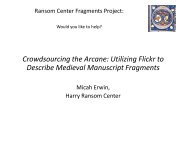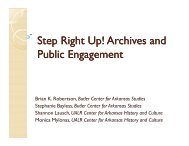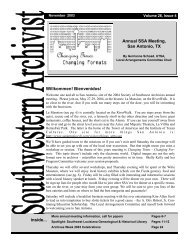Page 8<strong>Southwest</strong>ern ArchivistWhen the Hypothetical becomes HydratedBy Ann T. Boltin and Lisa H. Lewis, Diocese <strong>of</strong> Baton RougeStudents from LSU’s School <strong>of</strong>Library Science volunteer theirtime in the conservation room.Courtesy <strong>of</strong> LSU.Before Hurricane Katrina, the disaster plan for the Diocese <strong>of</strong> Baton Rouge wasprepared by an archives graduate student for a preservation class project based onhypothetical scenarios. The Archives Department <strong>of</strong> the diocese was well aware <strong>of</strong> adisaster’s potential for harm to its collections. In the collective imagination, preparationsfor a tornado, a chemical spill or an explosion at a nearby oil refinery were considered.Although there were projections <strong>of</strong> the possibility <strong>of</strong> flooding in the greaterNew Orleans area, few believed that would happen. But no one had imagined thetremendous impact that this disaster would have on Baton Rouge and other nearbycommunities.Precautionary measures were taken at the diocesan <strong>of</strong>fices the weekend before HurricaneKatrina. Computers were backed up and unplugged, blinds were closed andtraditional hurricane “battening down <strong>of</strong> the hatches” was done. However, little elsefrom our disaster plan was used. No one had previously anticipated the immensescope <strong>of</strong> this disaster and its implications. With no precedent, adequate preparations could not have been made.After the storm, local community groups and individuals got busy dealing with the swarm <strong>of</strong> evacuees, limiting availableresources. Housing evacuees, assisting at shelters, collecting supplies, and providing necessary informationstrained the shared resources <strong>of</strong> commodities, transportation and <strong>of</strong>fice space necessary to effectively deal with thechallenge. Cooperation crossed personal boundaries into the institutional realm. Within a week <strong>of</strong> the hurricane, theArchdiocesan Archives <strong>of</strong> New Orleans had moved in to share the <strong>of</strong>fices <strong>of</strong> the Baton Rouge Diocesan Archives.The records <strong>of</strong> the Archdiocese moved much slower than either the floodwaters or the population. The Baton Rouge<strong>of</strong>fice served as a collection point for the records <strong>of</strong> the Archdiocese <strong>of</strong> New Orleans. A room was prepared and suppliesordered. All priests were encouraged to bring their church records, wet or dry, to Baton Rouge. It took nearlya month for the documents to begin to trickle in. In the meantime, the staff educated themselves, as best as theycould, on wet collection recovery procedures. However, no instructions or examples wereavailable that compared to the condition <strong>of</strong> the materials. Some were covered in oil;many smelled <strong>of</strong> sewage or were covered in slime. Most had been wet for weeks or evenmonths. Records arrived in garbage bags and plastic containers; one church brought in afile drawer with the records still stuck inside. Some records were wet, others just dirty ormoldy, but many needed attention and all came with interesting stories. Some had beenfloated to safety in coolers, others had been taken upstairs until the hurricane had passed,with half being brought down too soon, only to be flooded when the levees breached.These records were effectively salvaged and preserved due to partnerships formed in thespirit <strong>of</strong> cooperation. LSU’s Hill Memorial Library <strong>of</strong>fered the use <strong>of</strong> their freezer to killexisting mold, keep wet records from further molding, and buy time to formulate salvageplans. This allowed the Baton Rouge diocesan archivists to work on a manageable number<strong>of</strong> boxes in an organized manner. Local companies donated supplies to help furnishour on-site conservation room. Plastic crates from Pepsi Cola© were inverted and arrangedto form a surface around which air could freely flow and the books and documentscould be dried.St. Brigid Baptism bookdamaged by HurricaneKatrina. Courtesy <strong>of</strong> LSU.
<strong>May</strong> <strong>2006</strong><strong>Southwest</strong>ern Archivistcontinued from previous pageBaton Rouge Press provided a roll <strong>of</strong> blank newsprint which was cut into sheets and interleaved between wet pages toabsorb moisture.Resourcefulness and flexibility became the norm. It seemed an overwhelming task, but the work proceeded in earnest.NEH awarded an emergency salvage grant to <strong>of</strong>fset some <strong>of</strong> the costs. Dedicated students from LSU’s School<strong>of</strong> Library and Information Science program and a few community volunteers were recruited to assist in the recoveryefforts. The work progressed, slowly but surely, as the records <strong>of</strong> eleven church parishes were defrosted, dried, cleanedand re-housed. Over 120 sacramental books and ten cubic feet <strong>of</strong> school records were salvaged; all will be micr<strong>of</strong>ilmedand the books copied for future use in the parishes. The originals will be archived.Eight months after the storm, a thorough review <strong>of</strong> the disaster response is in order. It is now apparent that more thanone scenario must be considered in disaster planning: the case where the local community hosts another communitywhich has been evacuated as well as the case where the local community itself experiences the disaster directly andhas to be evacuated. Therefore, preparation plans have changed. Disaster planning has trickled down through f theadministration. Although some evacuation procedures existed before Katrina, it is now mandatory that pastors inevacuated areas ensure the evacuation <strong>of</strong> essential records, even if the pastor himself decides not to leave. No longeris disaster planning a mundane exercise outlined on paper destined to live out its useless days in the dark, dusty depths<strong>of</strong> someone’s file cabinet. Rather, disaster planning is approached from the standpoint <strong>of</strong> what could really happen.This archives department has been charged with the writing <strong>of</strong> a disaster plan not only for their own holdings, but als<strong>of</strong>or the records <strong>of</strong> all churches within the diocese. Furthermore, all disaster planning documents are being revised froma more practical point <strong>of</strong> view. It’s not just a required exercise anymore; emergency preparedness now requires theidentification <strong>of</strong> real measures to aid in real-life, community changing situations that now seem all too possible.Katrina and the Sisters <strong>of</strong> St. Jospeh ArchivesSubmitted by Sister Jane Aucoin, csj, ArchivistMercifully, Hurricane Katrina spared the Archives <strong>of</strong> the Sisters <strong>of</strong> St. Joseph in New Orleans. Housed on the secondfloor, beneath a heavy slate ro<strong>of</strong>, the collection survived. However, four feet <strong>of</strong> water invaded the ground floors,remaining there for at least three weeks, giving mold and mildew the tropical conditions they welcomed with explosiveenergy. By the time it was safe to enter, some six weeks post Katrina, it had become painfully clear that buildingrestoration was out <strong>of</strong> the question for us. Receipts from insurance and emergency aid would barely cover the costs<strong>of</strong> cleaning up. We Sisters now have no choice but to sell the properties that had housed us and our ministries <strong>of</strong> spirituality,education, and care <strong>of</strong> our elders since 1950. Archives would have to move to Baton Rouge.For six weeks, we searched for appropriate rental space and then turned to the task <strong>of</strong> preparing the collection for transfer.Week after week generous volunteers and I—Sisters and devoted lay friends—trekked to New Orleans, packingup and preparing for the move. Finally, on December 5, we loaded 160 large cartons <strong>of</strong> materials and all the necessaryfurnishings into two large vans. By 9:30 that very night all cartons were stacked in one room and the furniture was inplace—including sixteen seven-foot shelving units that had to be squeezed into rooms with eight-foot ceilings. Twoweeks later, all the materials had been shelved and the now empty cartons—195 pounds—hauled away for recycling.Christmas holidays were never so gratefully welcomed!The $2000 Katrina assistance grant from SSA/SAA helped cover moving expenses. Just knowing we had such supportwas a big morale booster! As I write this, four months after the move, nearly all is in its proper place, except forthe occasional misplaced file. And the Katrina story as it affected the Sisters <strong>of</strong> St. Joseph joins all the other sagas<strong>of</strong> storms and floods, fires and robberies that our fore-Sisters and their lay colleagues have faced and overcome, withfidelity and grace, during the past 150 years <strong>of</strong> their presence along the Gulf coast.








